With life safety at stake, taking time to understand these key characteristics is essential before purchase
On Oct. 19, firefighters used a ladder, crane, and life safety rope to help a construction worker to safety during a “high angle rescue” in uptown Charlotte, NC.
In this video recorded by a passer-by, a firefighter is carefully lowered from the building on a life safety rope while clutching a rescue basket with the construction worker inside. It’s unclear why the worker needed to be rescued, but in less than a half-hour, he and the firefighter were safely on the ground.
High-angle rescues are made on terrain with a slope of 60 degrees or higher. The higher the angle, the more challenging and technical a rescue becomes because more weight is dependent on the rope setup instead of the ground.
“Not clear what proceeded it, but came across the rescue itself and it was awe-inspiring,” the passer-by tweeted with video and pictures from the scene, which were republished in the Charlotte Observer.
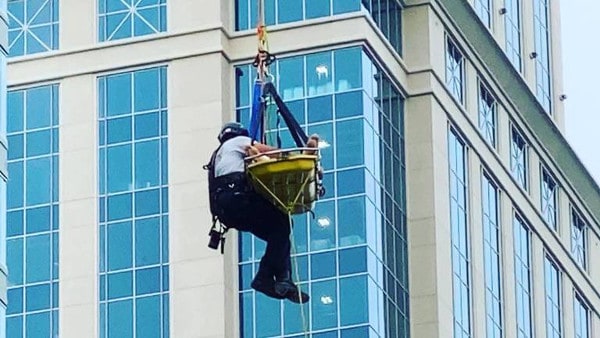
Headlines abound with similar rope rescues, and even more don’t make the news but are successfully performed by fire departments and other personnel nationwide. With people’s lives literally on the line, ensuring that the rope that’s used in these dangerous situations meets or exceeds life safety requirements for the job at hand can’t be emphasized enough.
But with so many rope choices on the market, how do firefighters determine which rope has the right characteristics to meet their needs?
In the first installment of our two-part series on selecting life safety rope, we examined the differences between technical-use and general-use life safety rope and helped firefighters determine which one they need for their operations. Then we reviewed three of the most important characteristics firefighters should consider for selecting technical-use rope: material, construction, and minimum breaking strength.
In this blog, we dig into the remaining characteristics that impact the selection of technical-use life safety rope.
In the market for rope? Be sure to view our rope selection, including our technical-use life safety rope, Bulwark Safety X, and the glow-in-the-dark Night Saver, which illuminates the path to safety in marine rescues, firefighting, and other applications.
A quick review of life safety rope basics
Before we get started, let’s quickly review some important background from Part 1 of our rope selection series:
- All life safety rope must meet specific physical standards and characteristics defined by the National Fire Protection Association (NFPA). The 2018 edition of NFPA 1858: Standard on Selection, Care, and Maintenance of Life Safety Rope and Equipment for Emergency Services offers minimum requirements for rope selection and care. The 2017 edition of NFPA 1983: Standard on Life Safety Rope and Equipment for Emergency Services specifies minimum performance requirements that ropes must meet in order to be used by emergency personnel during rescue operations.
- The umbrella term “life safety rope” encompasses technical-use and general-use rope, yet both types have extremely high safety ratings in all critical dimensions (loads, falls, etc.). NFPA 1858 (5.1.2 and A.5.1.2) offers guidance to help firefighters determine when each type of rope is needed. Essentially, the heaviest loads require general-use rope, while technical-use rope is assigned to relatively lighter loads. The lighter weight of technical-use rope is also often preferred by rescuers with more advanced and specialized jobs, who have the training and experience to maintain safety despite using a rope that isn’t quite as strong as general-use rope.
With all of this in mind, here are the remaining characteristics that firefighters and other rescuers should consider when selecting life safety rope, as recommended by NFPA:
Elongation characteristics
NFPA places emphasis on a rope’s elongation features:
From the 2018 edition of NFPA 1858
5.2.4* Elongation, including but not limited to low stretch or static, shall be considered.
Both low-stretch and static are appropriate elongation ranges for life safety rope. The topic of elongation is complex—for a more in-depth explanation, read up on why static is preferred over dynamic for rigging and hauling in rescue operations.
The elongation capacity of rope refers to the scale of static to dynamic. Low elongation (less give) is at the static end of the scale, while a high elongation is termed, generally, as “dynamic.” NFPA 1983 requires life safety rope to have no less than 1% elongation at 10% minimum breaking strength (MBS).
From the 2017 edition of NFPA 1983
7.1.1* Technical-use life safety rope shall be tested for breaking strength and elongation as specified in Section 8.2 and shall have … a minimum elongation that shall not be less than 1 percent at 10 percent of breaking strength, and a maximum elongation that shall not be more than 10 percent at 10 percent of breaking strength.
NFPA 1858 (A.5.2.4) designates five general categories of elongation. Life safety rope for firefighters falls squarely within the first two ranges:
- Static rope, a rope with a maximum elongation of 6% at 10% MBS. Static life safety rope is generally used when rope stretch is an issue, such as long rappels or rope systems using a long length of rope.
- Low-stretch rope, from 6% to 10% elongation at 10 percent MBS. This rope balances a lower amount of stretch with some elongation to absorb energy if shock loads occur—for instance, when arresting a falling rescuer or litter. Determining proper elongation is tricky, however: there is a trade-off between creating a high impact force by stopping a fall quickly and lessening the chances of hitting something on the way down.
- Moderate-stretch rope, classified as a special-use rope and defined by NFPA 1983 as “moderate elongation life-saving rope.” Its elongation is greater than 10% and less than 25% of the rope’s MBS. Its greater elongation allows for a lower impact force, but there is more movement when the rope is loaded with weight. It is not classified as life safety rope by NFPA 1983.
- High-stretch rope has an elongation greater than 25% at 10% MBS. Again, for technical-use life safety rope, elongation cannot exceed 10%.
- Dynamic rope is a very high elongation rope—usually 8% at bodyweight but rising to 40-50% elongation of break. It typically falls outside the scope of NFPA 1983, with requirements based on the UIAA climbing rope standard. UIAA is a certifying body for rock climbers and mountaineers, the primary consumers of dynamic rope worldwide. However, dynamic rope is sometimes permitted for fire rescue operations when a fall factor greater than 0.25 is expected, such as when a rescuer must lead climb to a person threatening suicide by jumping from a height. Fall factor is calculated by dividing the distance the person attached to the rope will fall by the length of the rope between the person and the rope anchor or belay (NFPA 1983: A.3.3.21).
The Bulwark Safety X technical-use rope has as little as 2% elasticity at 300 lbf (pound-force), and only reaches 5.8% elongation at 1,000 lbf. That exceeds even the tougher standards for static rope of the Cordage Institute (also mentioned in NFPA 1983), which requires 6% elongation at 10% MBS.
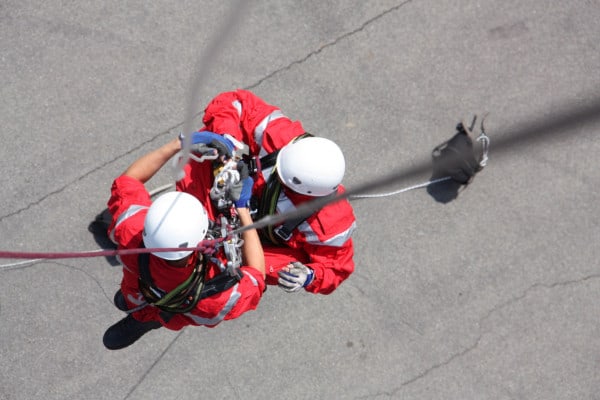
Diameter and weight
Diameter and weight are key factors that go hand-in-hand for rope selection:
From the 2018 edition of NFPA 1858
5.2.6* The diameter shall be considered to ensure compatibility with the other components used in the system and the ability to grip the rope.
5.2.7* The total weight to be carried shall be considered as it is determined by length, diameter, and material of the rope.
The diameter should be appropriate to how the rope will be used with other safety equipment and within the rope system as a whole. A.5.2.6 explains that equipment such as pulleys, ascenders, and descent-control devices may fail to work properly if they aren’t matched with a rope that’s the right diameter—and in some combinations, a very small difference in rope diameter can significantly impact performance. Fire rescue organizations must carefully ensure that the ropes they select match the requirements of the devices they own or have tagged for future purchases.
Larger diameter ropes are generally stronger and easier to grip by hand, but they also are heavier. For technical-use rope, specifically chosen for its lighter weight, NFPA 1983 sets the following diameter requirements (emphasis added):
From the 2017 edition of NFPA 1983
7.1.3* Technical-use life safety rope shall be tested for size as specified in Section 9.1 of Cordage Institute specified in Section 9.1 of Cordage Institute Standard CI 1801, Low Stretch and Static Kernmantle Life Safety Rope, and shall have a diameter of 9.5 mm (3∕8 in.) or greater but less than 12.5 mm (1∕2 in.). For reporting purposes, the calculated diameter of all new life safety rope shall be rounded to the nearest 0.5 mm (1∕64 in.).
The lightest weight rope that meets technical-use safety standards is usually preferred, but weight must be judged in the context of critical safety and usage characteristics (construction, material, and diameter) that we have discussed. Firefighters must assess several factors, such as MBS and diameter, while considering weight in order to avoid scenarios in which hauling weight over distance could shorten response time or interfere with the feasibility of a rescue.
Handling and color characteristics
A rope’s handling—its flexibility and smoothness when tying knots or running it through equipment—is often referred to as its “hand.” The way a rope feels is an important consideration in rope selection, since some synthetic fibers move more smoothly through hands and gloves. Factors such as knot tying and smoothness will impact use in bare hands, gloves, and over metal safety equipment.
If the rope satisfies requirements for construction, elongation, and MBS, then handling can be a variable to consider. For example, polyester sheath with nylon core will create a more forgiving feel that is easier to handle, especially when using bare hands.
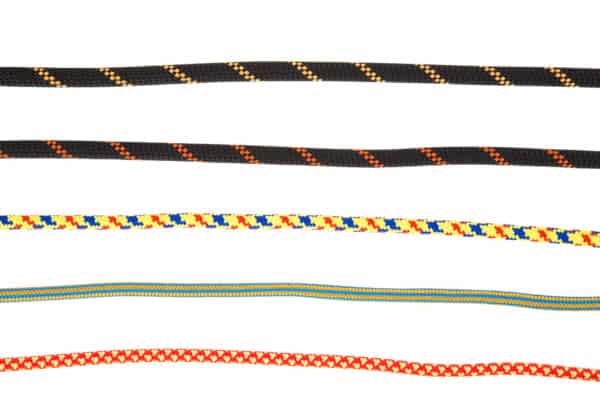
Rope flexibility and softness are also factors in rope systems that use carabiners, ascent, and belay devices. A softer rope will glide more smoothly through such equipment, but one that is too soft is more difficult to unknot and release once it has been tightened under load. Ropes with soft “hands” can also overly flatten out over edges or when running through descent control devices.
Conversely, ropes with stiff hands may not run as smoothly through gear but are more resistant to abrasion, don’t flatten as much in devices, and make it easier to untie loaded knots. When selecting technical-use rope, the pliability and interaction with rescue systems are both important considerations. NFPA 1858 (A.5.2.8) asserts that the correct choice for rescue operations often falls somewhere between these two extremes, depending on the devices in the rope system and the environment the rope will be rigged in.
From the 2018 edition of NFPA 1858
5.2.8* The hand shall be considered for ease of tying knots, smoothness running through the gear, and abrasion resistance.
Brighter-colored rope such as white or yellow may be more appropriate for low-light rescue. When purchasing several rope bundles, it can be helpful to choose colors with contrast, so that ropes used together during rescue operations can be quickly distinguished. For instance, the main line could be one color and the belay line another, or color could be used to designate ropes of different sizes.
From the 2018 edition of NFPA 1858
5.2.9* The rope color shall be considered for the ability to be seen or camouflaged, as well as the ability for one rope to be distinguished from another when rigged side by side.
Color is the last variable, however, in considering what rope to invest in. Only when all safety specifications are met is color a consideration.
Appropriate life safety rope length
NFPA 1858 specifically addresses length:
From the 2018 edition of NFPA 1858
5.2.10* The length shall be considered, including but not limited to lengths sufficient to rig the longest anticipated site, with additional rope length for anchoring, mechanical advantage systems, or other rigging needs.
NFPA 1858 (A.5.2.10) elaborates on these considerations. When selecting for length, firefighters must consider how much slack is necessary to wrap around and through other equipment like pulleys and ascenders. For rigging, it is always beneficial to have more rope than less, but having several shorter lengths of technical-use rope can be helpful for connecting rope or other devices.
A long rope can also offer more distance and safety from hazardous areas. For rescues from higher structures, longer ropes will allow a smoother rescue by avoiding the cumbersome process of passing a knot through a device or system.
When selecting rope, however, it is helpful to calculate reasonable amounts because storage and transport of excessive amounts of rope will use up significant space. Shorter ropes also weigh less, which makes them easier to carry.
NFPA 1858 recommends a comprehensive assessment of tall structures or deep drops such as bridges, radio towers, dams, tunnels, and ventilation or mine shafts within a jurisdiction to help gauge the rope length that’s required. Any of these has the potential for a rope rescue operation. NFPA also suggests having a variety of rope lengths on hand.
From the 2018 edition of NFPA 1858
A.5.2.10 Jurisdictions that have a wide variety of heights should consider carrying different lengths of ropes. For rescues from a lower height, a shorter rope will reduce the bulk and weight needed to be carried to the rigging area.
Standard available rope sizes are discussed in the final section on rope purchasing. The 600-foot and 1,200-foot sizes of QRFS’ Bulwark Safety X technical-use life safety rope are generally preferred by firefighters, although the rope comes in a variety of other lengths. Custom lengths are also available upon request.
Heat is an important factor in life safety rope selection
When a rappel device such as a figure eight or rack system is used for a rapid descent, the friction between rope and device generates significant heat. The rope must be able to withstand this, so all true life safety rope is manufactured with a heat-resistant rating. In addition, and of particular interest for firefighters, ropes are rated with a melting point.
From the 2018 edition of NFPA 1858
A.5.2.11* The heat resistance shall be considered, including but not limited to melting point, critical temperature, and friction.
The capacity to handle friction and critical temperature are other factors to take into consideration. The science of friction is a complex topic, but three factors influence what is known as friction force (FF): the load of the rope, the coefficient of friction (resistance to slipping), and the angle at which the rope turns. Environmental conditions, such as mud or moisture, are also known to impact friction. Critical temperature refers to the temperature at which rope degrades as a result of only temperatures, all other conditions being negligible and/or equal.
NFPA boils heat down to friction and exposure to the intense temperatures of fires. For the latter, the technical-use rope melting point is the critical piece of data.
NFPA 1983 requires technical-use life safety rope to have a melting point of not less than 400°F. But the performance of nylon and polyester life safety rope will start to degrade at temperatures below the fibers’ melting point. For that reason, it’s essential that firefighters take measures to protect rope used on the fire ground or near high temperatures.
From the 2017 edition of NFPA 1983
7.1.5* Fiber utilized for all life safety rope shall be tested for melting as specified in ASTM E794, Standard Test Method for Melting and Crystallization Temperatures by Thermal Analysis, and shall have a melting point of not less than 204°C (400°F).

Sheath factors
With one of the most popular rope styles, kernmantle, the sheath is an important element. The sheath provides protection, reduces twisting, and improves handling.
From the 2018 edition of NFPA 1858
5.2.12* For construction that includes a sheath, the sheath shall be considered, including but not limited to the number of yarns, braid patterns, thickness, and tightness as they apply to the hand; the abrasion resistance; and the amount of sheath slippage.
Overall rope durability with sheathed ropes is another plus, and the sheath should be evaluated for the number of yarns, its braid pattern, and its thickness and tightness. These specifications are related to abrasion resistance and the level of potential slippage.
Sheath designs can also impact the interface between a rope and devices in the rope system, such as pulleys, rope grabs, and belay devices. Fire rescue organizations should carefully evaluate the interaction of its equipment with various styles of rope and features to determine the best performance.
Once a life safety rope is selected and purchased, you must maintain it
Selection and purchase are only pieces of the puzzle for firefighters when it comes to technical-use rope. Equally important is care and storage, also covered in detail in NFPA 1858. In addition, rope selection and purchase should consider other features, such as but not limited to:
- Portability: smaller rope for single-use
- Gloves vs. hands: slimmer rope is acceptable for ungloved applications
- Exposure: rope degradation is an issue, but can partially be overcome with proper storage
- Cleaning: a regular cleaning routine prior to storage is a critical task
It is critical that each rope is labeled, stored and cared for according to its material and lifespan, using a systematic method. Some types of rope are more sensitive to dampness, others can degrade quickly in bright sunlight—but all rope needs to be bagged and protected when not in use. Firefighters should receive regular training in rope types, care, and identification.
Life safety rope in perfect condition can be set alongside weakened rope and they may appear indistinguishable. The only guaranteed method to assess rope condition is through regular maintenance and evaluation.
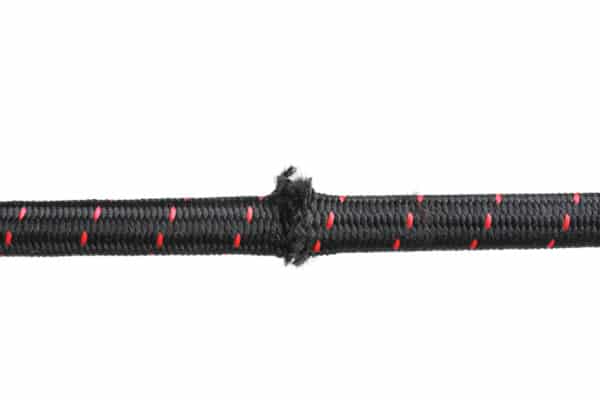
Rope can never be solely evaluated by sight, touch or age—it requires regular care and assessment based on usage, age, storage, climate, and material. For this reason, all rope (whether life safety or generic nylon) must be labeled, cleaned, and stored properly. Using a rope with an unknown history can result in a catastrophe.
For more information about care and storage of life safety rope, read our blog: Life Safety Rope: NFPA Requirements for Cleaning and Storage.
Bulwark Safety X: Multiple lengths, many advantages
Firefighters purchase rope in large quantities. When in the field, it is better to have far too much than be a few inches short, and static rope is not generally sold in coils under 100 feet. The UL-listed Bulwark Safety X uses the highest-quality kernmantle construction, in 150’, 600’ or 1,200’ feet of static rope. Custom lengths are also available upon request. This brand meets or exceeds technical-use life safety rope standards listed in NFPA 1983.
All Bulwark Safety X varieties are 11mm (or 7/16ths) diameter in a 100% nylon core with a polyester sheath. The core is 6.6 rated, and constructed to reduce rotation (twist) when under load and during rappel. With cover material made from high-tenacity polyester and a melting point of 485 degrees, this rope is excellent for fire rescue operations.
At 5.6 pounds for 100’, this is a relatively lightweight rope with low elasticity (2.0% at 300 pounds; 3.0% at 600 pounds; 5.8% at 1,000 pounds) and a recommended working load of an impressive 1,335 pounds.
Bulwark Safety X is tested to the highest specifications at its point of manufacture at Canada Rope and Twine, Ltd., in Nova Scotia. This rope comes in stock in one color pattern—white with red highlights—which is optimal for daylight use and acceptable for low-light conditions. It is also available in custom colors by special order.
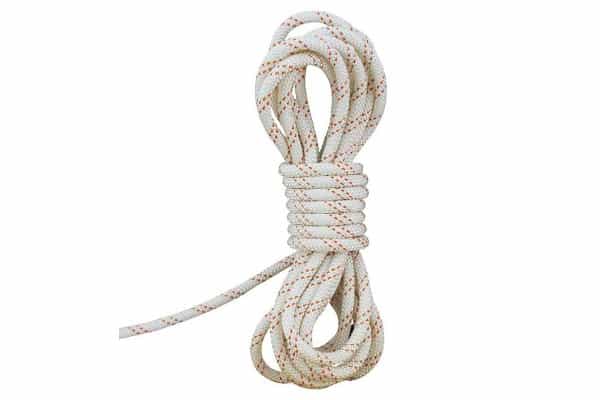
Selecting the right life safety rope means checking off the right boxes
With awareness of the characteristics of life safety rope, selection and purchase are a matter of ticking off all the right boxes. Once the proper materials, construction, elongation, diameter, and heat resistance are in place, considering handling and color can begin. Dependable life safety rope made from quality materials meet or exceed industry and NFPA standards.
For more information about selecting life safety rope, be sure to check out the first installment in our two-part series: Life Safety Rope: NFPA Selection Requirements for Technical-Use Rope, Part 1.
View our selection of rope, including the technical-use life safety rope, Bulwark Safety X, and the glow-in-the-dark Night Saver, which illuminates the path to safety in marine rescues, firefighting, and other applications.
If you have any questions, need help finding an item, or you’d like to order custom sizes or colors of rope, contact us at +1 (888) 361-6662 or support@qrfs.com.
This blog was originally posted at blog.qrfs.com. If this article helped you, check us out at Facebook.com/QuickResponseFireSupply or on Twitter @QuickResponseFS.


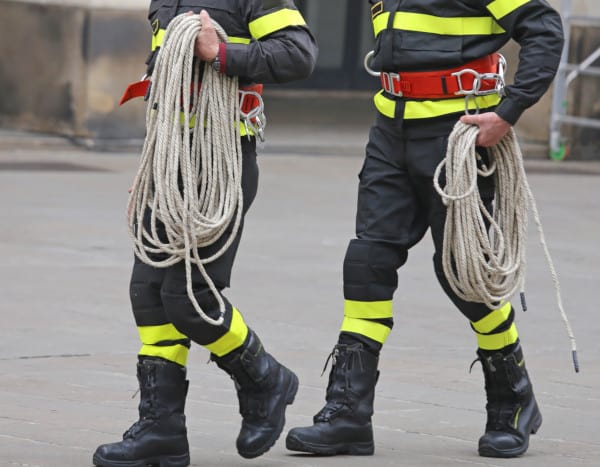
I am a safety advisor and am looking for some facts about rescue rope. The rescue would be off of a powerline pole.
John, thanks for reaching out. We have several articles on rescue rope that we hope answer your questions:
https://blog.qrfs.com166-glow-in-the-dark-rope-the-applications-of-the-best-in-class-night-saver/
https://blog.qrfs.com171-life-safety-rope-for-firefighters-the-bulwark-safety-x/
https://blog.qrfs.com197-life-safety-rope-nfpa-requirements-for-cleaning-and-storage/
https://blog.qrfs.com202-is-it-time-to-retire-your-life-safety-rope/
https://blog.qrfs.com288-life-safety-rope-nfpa-requirements-for-choosing-the-right-rope-part-1/
https://blog.qrfs.com289-life-safety-rope-nfpa-requirements-for-technical-use-rope-part-2/
Do you have any information on dropping a bag of rope from heights and there being any damage associated with it? One end attaches up top and the bag then tossed down to the ground. Any information on this would be great. Thanks
Eddie — We don’t have any info on excessive damage to rope from dropping it down from a height while it is still attached — beyond any damage from longtime use or weight beyond a rope’s ratings and capabilities. What you describe (hanging/dropping rope) is part of the essential function of life safety rope. Thanks for reading.